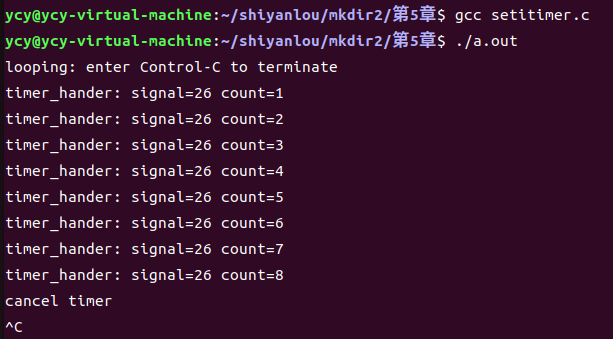《Unix/Linux系统编程》学习笔记8
第五章 定时器及时钟服务
一、知识点归纳
(一)硬件定时器
定时器是由时钟源和可编 程计数器组成的硬件设备。时钟源 通常是一个晶体振荡器,会产生周期性电信号,以料青确的频率驱动计数器。使用一个倒计时值对计数器进行编程,每个时钟信号减1。当计 改减为0时,计数器向CPU生成一个定时器中断,将计数值重新加载到计数器中,并重复复倒计时。计数器周期称为定时器刻店度,是系统的基本计时单元。
(二)个人计算机定时器
(三)CPU操作
(四)中断处理
(五)时钟服务函数
1.gettimeofday-settimeofday
#include<sys/time.h>
int gettimeofday(struct timeval *tv, struct timezone *tz);
int settimeofday(const struct timeval *tv, const struct timezone *tz);这些是对 Linux 内核的系统调用。第一个参数 tv 指向一个 timeval 结构体。
struct timeval{
time_t tv_sec; /* seconds */
suseconds_t tv_usec; /* microseconds */
};第二个参数 timezone 已过期,应设置为 NULL。gettimeofday() 函数用于返回当前时间(当前秒的秒和微秒)。settimeofday() 函数用于设置当前时间。在 Unix/Linux 中,时间表示自 1970年1月1日 00:00:00 起经过的秒数。它可以通过库函数 ctime(&time) 转换为日历形式。下面给出了 gettimeofday() 函数和settimeofday() 函数的示例。
(1)gettimeofday 系统调用
(2)settimeofday 系统调用
2.time 系统调用
3.times 系统调用
times 系统调用
clock_t times(struct tms *bus);可用于获取某进程的具体执行时间。它将进程时间存储在 struct tms buf 中,即:
struct tms{
clock_t tms_utime; // user mode time
clock_t tms_stime; // system mode time
clock_t tms_cutime; // user time of children
clock_t tms_cstime; // system time of children
}以时钟计时单元报告所有时间。这可以为分析某个正在执行的进程提供信息,包括其子进程的时间(如有)。
4.time 和 date 命令
- date:打印或设置系统日期和时间。
- time:报告进程在用户模式和系统模式下的执行时间和总时间。
- hwclock:查询并设置硬件时钟(RTC),也可以通过 BIOS 来完成。
(六)间隔定时器
-
setitimeer 程序代码
(七)REAL 模式间隔定时器
(八)编程项目
1.系统基本代码
2.定时器中断
3.定时器队列
4.临界区
5.高级主题
二、问题与解决思路
三、实践内容与截图
1.gettimeofday 系统调用
#include<stdio.h>
#include<stdlib.h>
#include<sys/time.h>
#include<time.h>
struct timeval t;
int main()
{
gettimeofday(&t,NULL);
printf("sec=%ld usec=%ld\n",t.tv_sec,t.tv_usec);
printf((char *)ctime(&t.tv_sec));
}2.settimeofday 系统调用
#include<stdio.h>
#include<stdlib.h>
#include<sys/time.h>
#include<time.h>
struct timeval t;
int main()
{
int r;
t.tv_sec=123456789;
t.tv_usec=0;
r=settimeofday(&t,NULL);
if(!r){
printf("settimeofday() failed\n");
exit(1);
}
gettimeofday(&t,NULL);
printf("sec=%ld usec=%ld\n",t.tv_sec,t.tv_usec);
printf("%s",ctime(&t.tv_sec));
}3.time 系统调用
#include<stdio.h>
#include<time.h>
time_t start,end;
int main()
{
int i;
start=time(NULL);
printf("start=%ld\n",start);
for(i=0;i<123456789;i++);
end=time(NULL);
printf("end =%ld time=%ld\n",end,end-start);
}4.setitimeer 程序代码
#include<signal.h>
#include<stdio.h>
#include<sys/time.h>
#include<time.h>
int count=0;
struct itimerval t;
void timer_handler(int sig)
{
printf("timer_hander: signal=%d count=%d\n",sig,++count);
if(count>=8){
printf("cancel timer\n");
t.it_value.tv_sec=0;
t.it_value.tv_usec=0;
setitimer(ITIMER_VIRTUAL,&t,NULL);
}
}
int main()
{
struct itimerval timer;
signal(SIGVTALRM,timer_handler);
timer.it_value.tv_sec=0;
timer.it_value.tv_usec=100000;
timer.it_interval.tv_sec=1;
timer.it_interval.tv_usec=0;
setitimer(ITIMER_VIRTUAL,&timer,NULL);
printf("looping: enter Control-C to terminate\n");
while(1);
}






【推荐】国内首个AI IDE,深度理解中文开发场景,立即下载体验Trae
【推荐】编程新体验,更懂你的AI,立即体验豆包MarsCode编程助手
【推荐】抖音旗下AI助手豆包,你的智能百科全书,全免费不限次数
【推荐】轻量又高性能的 SSH 工具 IShell:AI 加持,快人一步
· 阿里最新开源QwQ-32B,效果媲美deepseek-r1满血版,部署成本又又又降低了!
· 开源Multi-agent AI智能体框架aevatar.ai,欢迎大家贡献代码
· Manus重磅发布:全球首款通用AI代理技术深度解析与实战指南
· 被坑几百块钱后,我竟然真的恢复了删除的微信聊天记录!
· AI技术革命,工作效率10个最佳AI工具